The fresh berry season means mini Pavlovas to me. That’s one of my favorite summer desserts I can never resist. I prefer them in one portion size as meringue cuts messily and hurts my inner esthete. Mini Pavlovas both taste and look amazing! They still break and crumble when you dig into them, but that’s not a huge problem, as those crumbles disappear so quickly.
What is Pavlova?
It’s a classic meringue-based dessert, originally topped with whipped cream, berries, and fruit. It perfectly combines sweetness, lightness, and crispiness. Pavlova is a type of meringue, but not every meringue is a Pavlova: a crispy exterior and soft marshmallowy interior that melts in your mouth are significant characteristics of this dessert. It might sound intimidating, but when you know what you are doing, Pavlovas are really easy to make!
Swiss meringue
Most often Pavlova recipes use a French method to make the meringue base. This method starts by whipping egg whites, then adding sugar little by little. It’s the most common way to make meringues and is very familiar for home bakers. But I prefer the Swiss method, which calls for gently heating the egg whites with sugar before beating them. Once I tried this one, I’m never getting back. The Swiss method produces a very smooth, silky, marshmallowy meringue, that is super stable and is really difficult (if at all possible) to fail. That’s a huge plus for me because (you’ve guessed it) I failed my French meringue sooo many times. The only downside of the Swiss method is less volume compared to the French method. So if you have never tried this technique before, don’t be alarmed. Slightly denser meringue is perfectly normal.
Balanced sweetness
Pavlova is usually topped with sweetened whipped cream and fresh berries, but improvisation is always welcome, isn’t it? Meringue is very sweet by itself, so I’ve tried a lot of slightly different fillings, to balance that sweetness out. I did not like the taste of unsweetened whipped cream, but adding some mascarpone and lemon juice made my taste receptors happy. Yours might prefer some different balance, so feel free to skip lemon juice or even add some icing sugar to the cream.
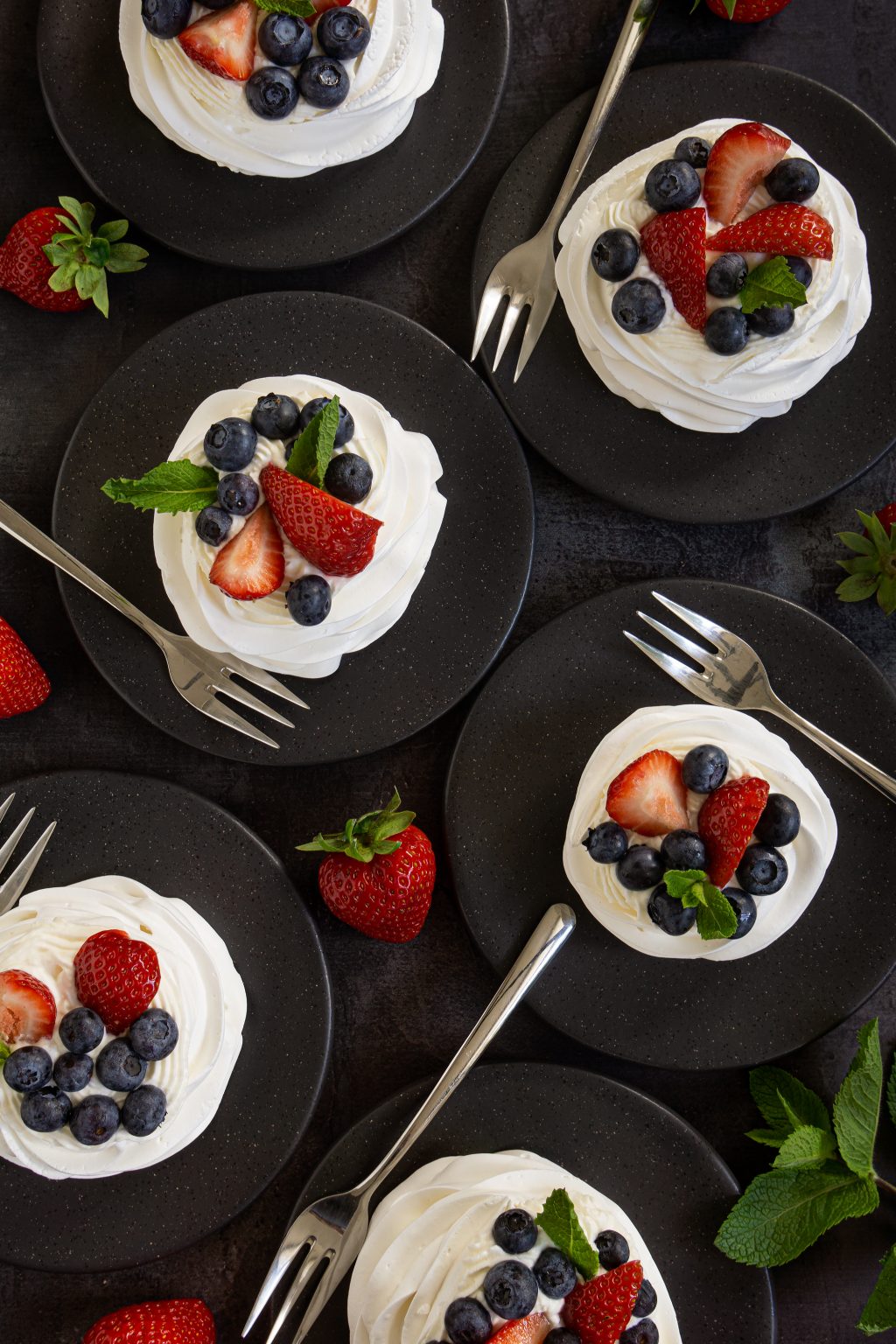
TIPS FOR MAKING PERFECT MINI PAVLOVAS
Make sure there is no trace of grease
The bowl and all tools that will touch the meringue have to be perfectly clean. To be sure, rewash them just before starting and wipe them with some vinegar or lemon juice.
Choose a metal, not a plastic bowl, because it’s super difficult to get the grease cleaned off of plastic.
Separate eggs when they are still cold and make sure no yolk gets into the whites. The yolk contains fat and it will prevent the egg whites from stiffening.
Weigh your egg whites
The egg is not equal to the egg. Medium size eggs might be quite different in different parts of the world. Correct egg white-sugar ratio is very important for a proper meringue texture and this ratio is not based on S, M, or L egg size. It’s based on weight, so weigh your egg whites.
How to achieve a crispy exterior and soft marshmallowy interior of the meringue?
The soft interior is underbaked meringue. Meringue, like anything else, does not bake equally all at once. Heat slowly travels from the outside of the meringue to the inside (it’s called diffusion of heat). So you will get a soft interior by baking just long enough and not too long.
Should you add cornstarch to the meringue and what happens if you don’t?
Most Pavlova recipes include some amount of cornstarch. Try to google why and you’ll get a bunch of different answers, like it stabilizes the meringue, or helps to achieve a soft, marshmallowy interior.
So what happens if you skip this ingredient? I’ve checked this with an experiment: baked two meringues of the same size, for the same amount of time at the same temperature. The only difference was that one contained some cornstarch, and the other did not. And… Nothing happened. The result was two identical meringues. Both had an equally crunchy exterior and an equally soft interior.
So obviously, cornstarch has nothing to do with the softness. Does it work as a stabilizer? Stabilization happens at the molecular level and I don’t have the tools to check this, but I did not find any article, discussing meringue science, that would back or explain this idea. Personally, I don’t understand why should I add ingredients, that do not change anything in the final result. But it does not damage it either, so feel free to add some cornstarch if you prefer for some reason.
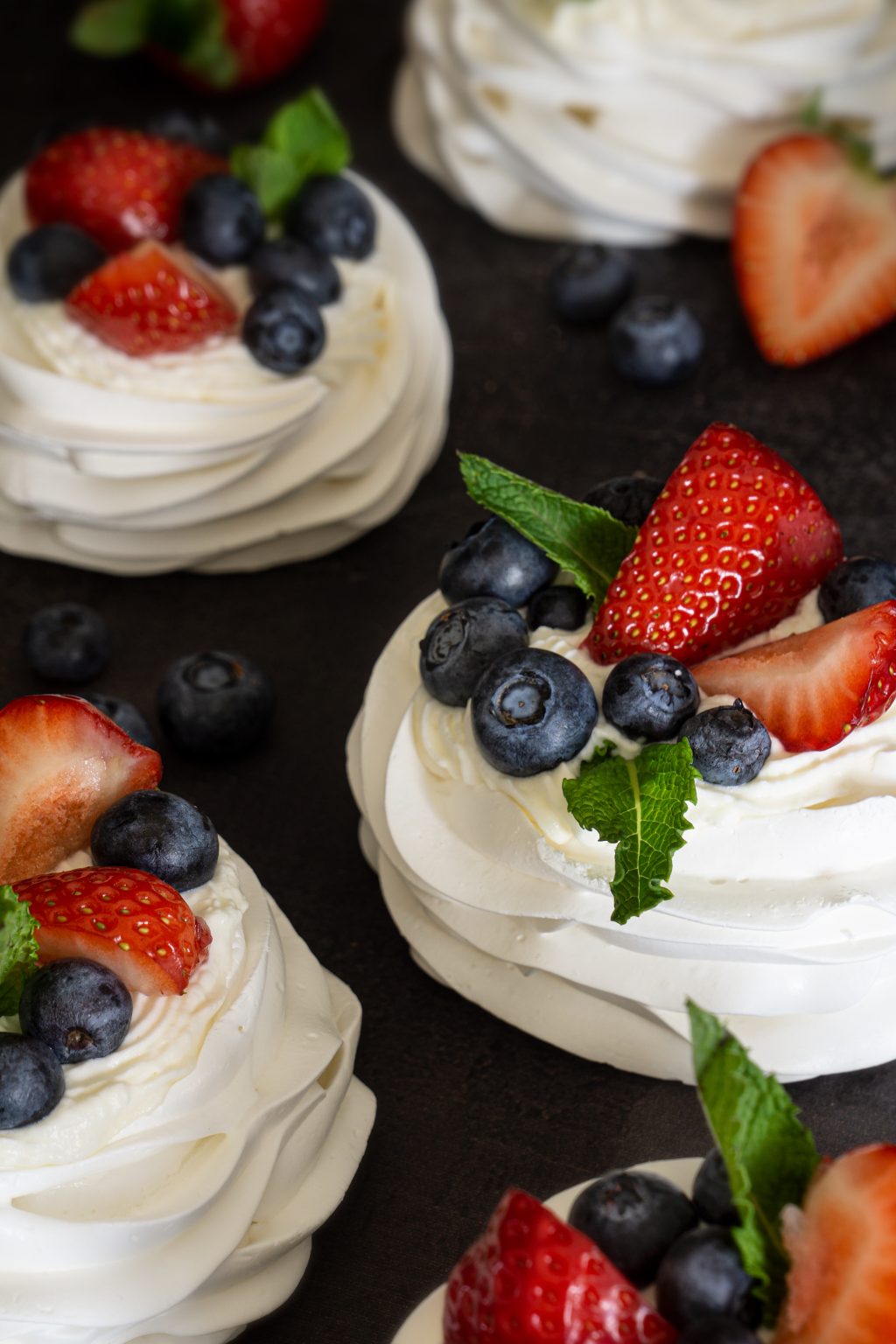
Why add acid (lemon juice, vinegar, or cream of tartar) to the meringue?
The acid helps to stabilize the meringue. I’ve learned about how it works in a book named Science and Cooking, and a lot of articles also talk about it (like this one on letstalkscience.ca). It’s not a huge difference in which kind of acid you choose (amounts would vary though). I prefer lemon juice because vinegar adds some smell and taste I don’t like, and cream of tartar is not usually found in my kitchen. It’s not an indispensable ingredient, so you can skip it, but at your own risk. Because adding some acid to your meringue is like having insurance.
Do eggs have to be at room temperature for the meringue?
If you would make a French meringue, room temperature would be important. But with this recipe, you will follow the Swiss method and heat egg whites before beating anyway. So you can start with cold eggs with no worries.
How long to bake mini Pavlovas and how to know when they are done?
This recipe makes 6 ~8 cm / 3.14 inch-sized Pavlova bases. In my oven, they are perfectly baked after 1 hour and 15 mins, but your oven is different, so you might need to slightly adjust the time. They are done, when you can easily lift them off the parchment paper, they hold their shape and the bottoms are not sticky or wet.
How to cool meringues?
When meringues are done baking, turn off the oven and let them cool inside for at least an hour or even overnight. If you take them out immediately, sudden temperature change can crack the meringues. OK, but how to check if they are baked, then? If you are baking meringues for the first time ever, and you are not sure if your oven was able to do its job properly on time, open it and check if you can lift the meringues. Close the oven and leave them to cool there after that. Even if they crack slightly, the taste will not change.
Can you assemble mini Pavlovas in advance?
Pavlovas should be served immediately after assembling. If they stay and wait for a long time, the meringue will absorb moisture from the filling (and from the air), will get soggy, and crumble. If you have no choice but to assemble them in advance, from my experience, they can survive a few hours if… They are left in a dry place, if the filling is not only whipped cream, and if it’s not too hot. Being said that, don’t put them in the fridge either, the fridge is a very moist place. I know, I know, it’s complicated, that’s why you should eat them at once.
How long can you keep mini Pavlovas?
If without filling, meringue bases can easily last for about a week. But only if kept in an air-tight container. Otherwise, they will absorb moisture from the air and get soft and chewy in a few days.
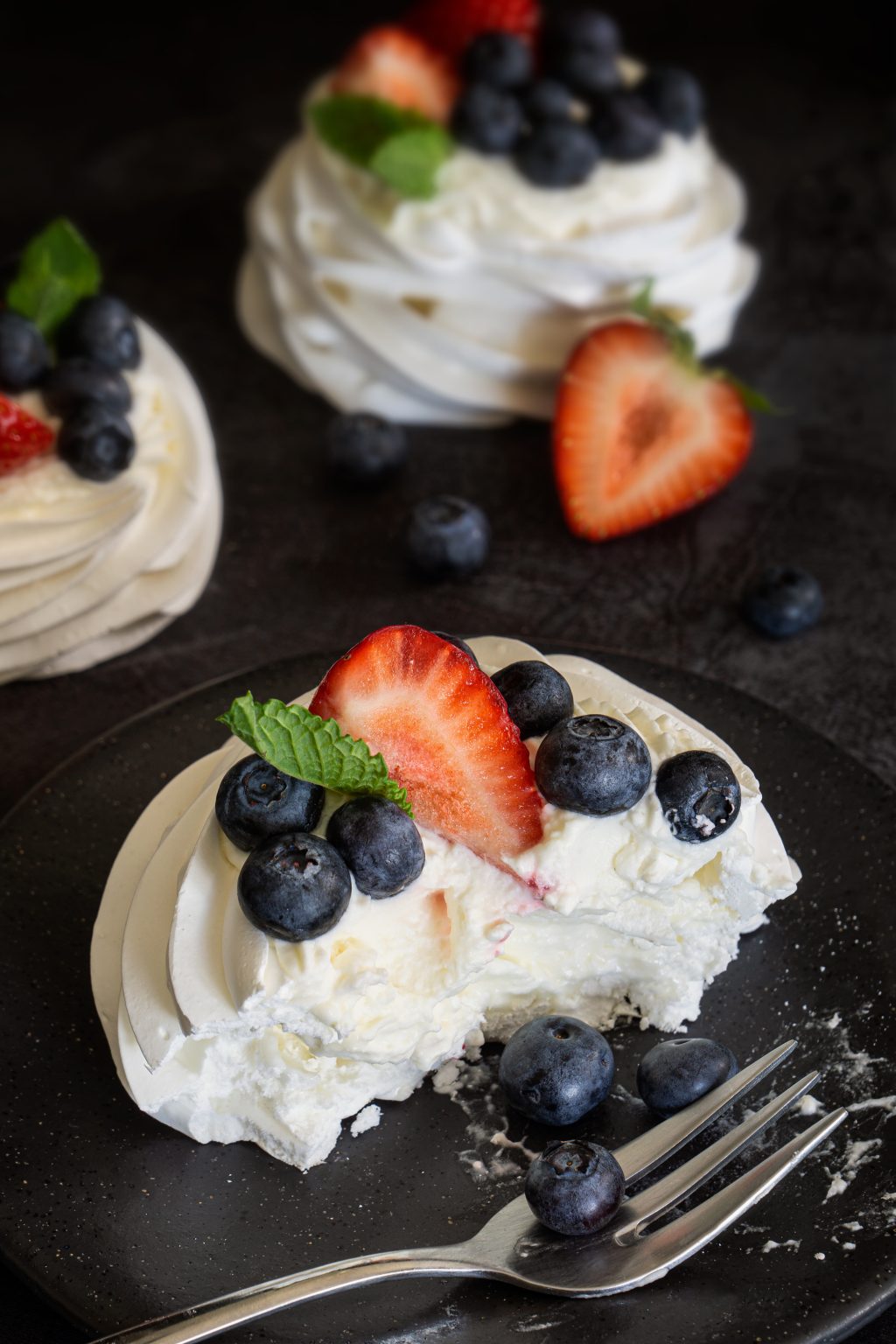
TROUBLESHOOTING MINI PAVLOVAS
Why won’t my egg whites stiffen?
Most probably, some fat sneaked into the egg whites. If it’s the reason, there is no way to fix it, you will have to start all over again. Or maybe you are trying to make meringue with less sugar? The sugar and egg whites ratio is very important and your meringue will not stiffen with too little sugar.
Why did my Pavlovas crack in the oven?
If you haven’t opened the oven during baking or immediately after that, the reason is too high temperature. If you baked them at 90°C / 195 °F and they still cracked, your oven temperature indicator might be off. Try to reduce the temperature the next time.
Why are my Pavlovas soft and sticky?
They’re most probably underbaked.
Why did my Pavlovas brown while baking?
To keep Pavlova bases white low oven temperature (90°C / 195°F) is important. If they still brown, your oven temperature indicator might be off. Try to reduce the temperature the next time.
Mini Pavlovas With Mascarpone Cream
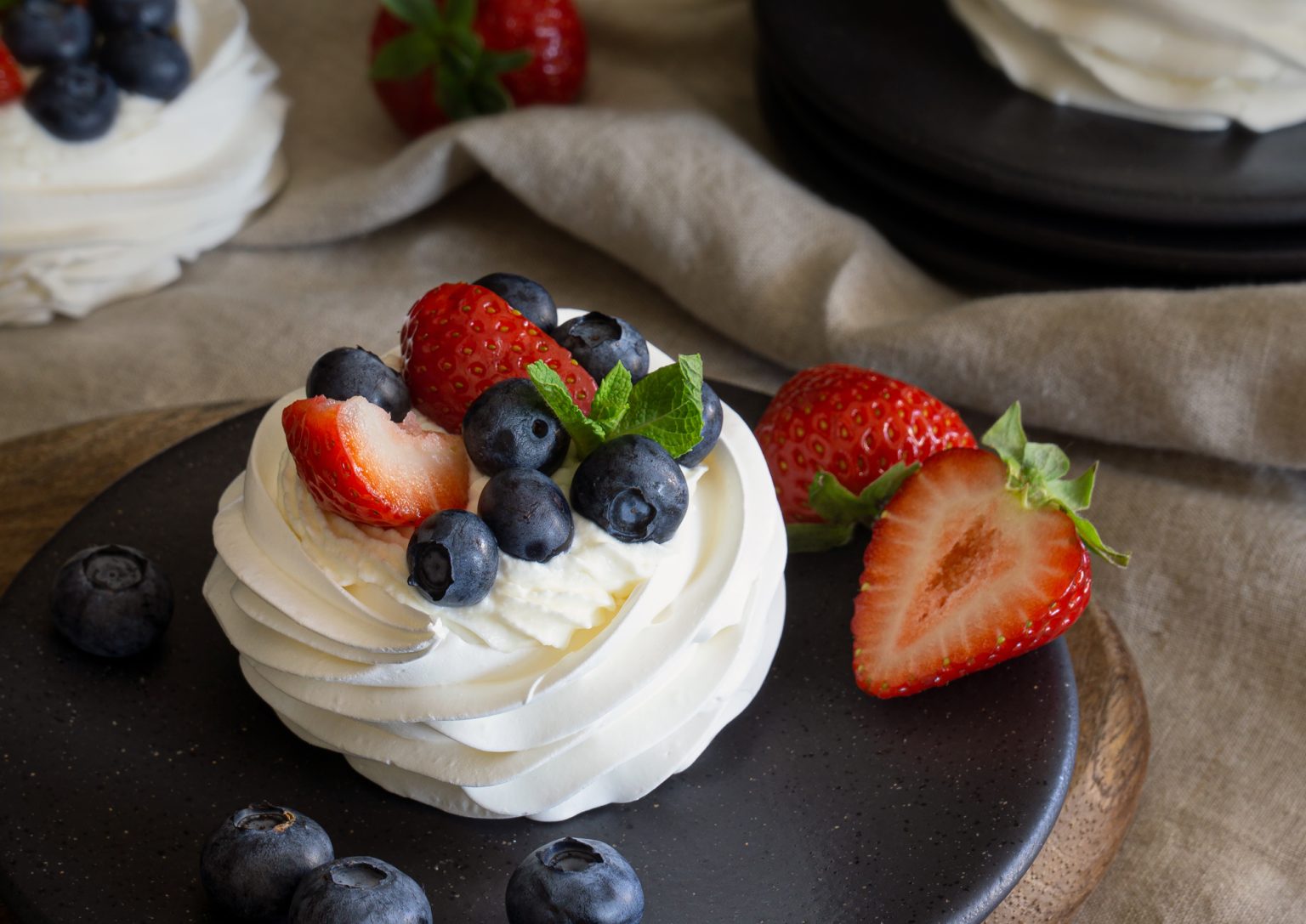
Sweet, light and terribly good-looking mini Pavlovas topped with mascarpone whipped cream and fresh berries. Follow my step-by-step recipe to treat yourself with this classic summer dessert.
- Prep Time40 min
- Bake / Cook Time1 hr 15 min
- Total Time1 hr 55 min
- Yield6 serv.
- Course
- Dessert
- Tags
Ingredients
Meringues
- 100 g / 3.5 oz egg whites (~3 medium egg whites)
- 180 g / 6.3 oz granulated sugar
- 1 tsp vanilla extract
- 1,5 tsp lemon juice
Filling
- 100 g / 3.5 oz mascarpone cheese
- 150 ml / 5 fl oz whipping cream (~35% fat)
- 30 ml / 1 fl oz lemon juice (~half of medium lemon)
- 1 tsp vanilla extract
- 6 fresh strawberries
- ~80 g / 2.8 oz fresh blueberries
Directions
Meringues
Draw 6 ~8 cm / 3.14-inch diameter circles on a parchment paper sheet.

Put the parchment paper on the baking sheet marked side down. This way you will still be able to see the circles but will avoid graphite marks on meringues.

Preheat the oven to 90°C / 195°F (without a fan).
Wipe the metal bowl, the whisk, and the spatula (everything that will be touching the meringue) with some vinegar or lemon juice.
Bring some water to boil in the pot on the stove. Reduce the heat to keep it steaming, but not boiling.
Mix the egg whites, sugar, and lemon juice in the metal mixing bowl. Put this bowl on top of the steaming water making sure that the bottom of the bowl is not touching the water. Heat the egg whites and sugar, mixing all the time, till sugar fully dissolves. Rub a small amount of the egg whites between your fingers to check if there are no sugar granules left. The heating process will take about 8 mins and the mixture will get white and opaque.

Optionally, after the sugar has dissolved, you can keep heating the egg whites till they reach 72°C / 161°F. This way you will kill any potentially harmful bacteria and have pasteurized egg whites.
Remove the egg whites from the heat and start beating them with a handheld or stand mixer at medium-high speed. Beat till the meringue is glossy and holds its shape when you lift the whisk attachment. With my Kitchen Aid stand mixer, it takes about 10 mins. Add vanilla extract just before the end.

Transfer the meringue to a piping bag and pipe six meringue nests: starting in the center, pipe a circle, then go around the edge twice to create a nest.

If you are not using a piping bag, form meringues with a spoon and make indentations in the middle by inserting the tip of the spoon diagonally and rotating it.

Piped meringues will look impressive, but the spooned ones, because of their simple and even shape, will have more of the marshmallowy center.
Bake the meringues for 1 hour and 15 mins. After they are done baking, leave them to cool in the oven for at least an hour or till they have cooled completely.
Keep meringues in the air-tight container till you are ready to assemble and serve.
Filling
Using an electric mixer or a hand whisk, mix mascarpone, lemon juice, and vanilla extract just until combined.

Add cold whipping cream and beat till medium-stiff peaks form. Use a slow-medium speed of an electric mixer and be careful not to overbeat.

Using a piping bag or a spoon, fill meringue nests with the cream.

Top with blueberries and sliced strawberries.

Serve immediately.


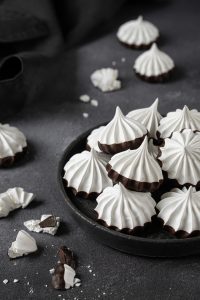

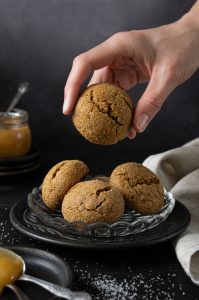
This recipe turned out great! I doubled everything and made 12 individual pavlovas. I used slightly less sugar (200g egg whites and 330g sugar) and went heavier on the mascarpone (8oz tub mascarpone with roughly 10oz heavy cream.) These porportions worked just fine with stability/texture/taste. I added about 2 tbs powdered sugar and a heavy tsp of diamond kosher salt to the mascarpone cream to liven it up a little more because my lemon wasn’t very bright. I worried at first that the pavlovas would be underbaked at 195f for 1h15 mins (they felt soft and tacky on the outside) but I trusted the recipe and by the time they had cooled in the closed oven for an hour they were perfectly crisp on the outside and marshmallowy on the inside! I served with some fresh chocolate sauce, a strawberry cut into a rose shape, and a few sprigs of rosemary. Delicious!